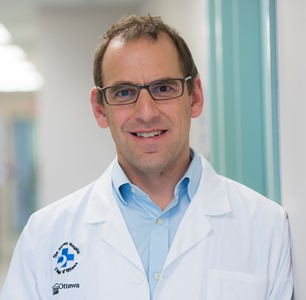 Ontario will achieve "single digit" tobacco smoking rates (under 10 per cent) by 2023 for women, and 2040 for men, according to a new big data report conducted jointly by the The Ottawa Hospital and the Institute for Clinical Evaluative Sciences (ICES).
Ontario will achieve "single digit" tobacco smoking rates (under 10 per cent) by 2023 for women, and 2040 for men, according to a new big data report conducted jointly by the The Ottawa Hospital and the Institute for Clinical Evaluative Sciences (ICES).
“This report is unique because we were able to combine tobacco smokers with their healthcare use. We looked at when people started and stopped smoking over their lifetime to create a realistic model of smoking in Ontario over the past 60 years. Using this, we were not only able to look at the past, but project into the future,” says Dr. Doug Manuel, lead author and senior scientist at ICES, The Ottawa Hospital, and professor at the University of Ottawa.
Tobacco smoking is a leading cause of preventable morbidity and mortality worldwide. In Canada, tobacco smoking-attributable mortality increased between 2002 and 2012, and in 2012, more than 45,000 deaths were caused by smoking with the direct health care costs of tobacco use estimated at $6.5 billion.
The report found that the number of people who have ever been tobacco smokers has dropped by half over time, with only 30 per cent of men born in 1990 becoming smokers by age 20, compared to 60 per cent of men who were born before 1950. Similarly, only 20 per cent of women born in 1980 became smokers as adults, compared to 40 per cent of women born in 1960.
The report also shows that sociodemographic factors play a role in who starts smoking and who doesn’t: men and women who do not complete high school will be two or three times more likely to smoke in 2041 compared to those who have university educations.
17.6 per cent of women with less than a high school education smoked versus 5.0 per cent of women who were post-secondary graduates.
16.3 per cent of men with less than a high school education smoked versus 6.8 per cent of men who were post-secondary graduates.
“Our report clearly demonstrates that stop-smoking efforts need to be better targeted to all groups, particularly those at highest risk of becoming smokers," says Manuel.
The report looked at administrative health records housed at ICES for all adult Ontario men and women beginning in the year 1960, making projections all the way up to 2041.
The report found:
- In 2003, tobacco smoking accounted for 9.5 per cent of all health spending in Ontario. By 2041, if the decrease in tobacco smoking rates continues, the researchers say this proportion will drop by more than one-third, to 5.9 per cent of total health spending.
- Between 2003 and 2041, there will be an estimated $51-billion reduction in tobacco smoking-attributable health care expenditures in Ontario.
- Despite this reduction, tobacco smoking-attributable health care expenditures will amount to $164 billion between 2003 and 2041.
“Tobacco smoking profoundly affects not only health but also almost all aspects of health care. Smoking harms nearly every organ and system in the body. Diseases directly related to smoking are a major source of hospital admission, but even seemingly unrelated admissions are also affected. A person who smokes and has hip surgery will have a greater risk of complications, slower recovery and more likely to require the surgery be redone than a non-smoker,” added Dr. Manuel.
The researchers add that investing in strategies to encourage the decrease of unhealthy behaviours such as smoking, ideally preventing the behaviours from starting in the first place, will go far to improve the health of Ontario’s population, while improving the sustainability of our health care system.
"Health Care Cost of Smoking in Ontario, 2003 to 2041” was published July, 12, 2018.
Author block: Douglas G. Manuel, Andrew S. Wilton, Adrian Rohit Dass, Audrey Laporte, Sima Gandhi and Carol Bennett.
The Institute for Clinical Evaluative Sciences (ICES) is an independent, non-profit organization that uses population-based health information to produce knowledge on a broad range of health care issues. Our unbiased evidence provides measures of health system performance, a clearer understanding of the shifting health care needs of Ontarians, and a stimulus for discussion of practical solutions to optimize scarce resources. ICES knowledge is highly regarded in Canada and abroad, and is widely used by government, hospitals, planners, and practitioners to make decisions about care delivery and to develop policy. For the latest ICES news, follow us on Twitter: @ICESOntario
The Ottawa Hospital is one of Canada’s largest learning and research hospitals with over 1,100 beds, approximately 12,000 staff and an annual budget of over $1.2 billion. Our focus on research and learning helps us develop new and innovative ways to treat patients and improve care. As a multi-campus hospital, affiliated with the University of Ottawa, we deliver specialized care to the Eastern Ontario region, but our techniques and research discoveries are adopted around the world. We engage the community at all levels to support our vision for better patient care. See www.ohri.ca for more information about research at The Ottawa Hospital.
University of Ottawa: —A crossroads of cultures and ideas
The University of Ottawa is home to over 50,000 students, faculty and staff, who live, work and study in both French and English. Our campus is a crossroads of cultures and ideas, where bold minds come together to inspire game-changing ideas. We are one of Canada’s top 10 research universities—our professors and researchers explore new approaches to today’s challenges. One of a handful of Canadian universities ranked among the top 200 in the world, we attract exceptional thinkers and welcome diverse perspectives from across the globe. www.uottawa.ca
For more information, please contact:
Amelia Buchanan
Senior Communication Specialist
Ottawa Hospital Research Institute
Office: 613-798-5555 x 73687
Cell: 613-297-8315
ambuchanan@ohri.ca
Deborah Creatura
Media Advisor, ICES
deborah.creatura@ices.on.ca
(o) 416-480-4780 or (c) 647-406-5996
